Shri Sai Baba is revered as one of the greatest saints ever seen in India, endowed with unprecedented powers, and is worshiped as a God incarnate. (SAI meaning Sakshaat Ishwar) – GOD THE ABSOLUTE.
This mysterious Fakir first made his appearance in Shirdi as a youth and remained there throughout his long life.
He transformed the lives of those who met him and continuously is doing so even after his Samadhi in 1918 for those whose hearts are touched by his love and who pray and call him at any emergency in life for his blessings.
Baba is, as one of his contemporary devotees put it, “The embodiment of the supreme spirit lighting the sadhakas (seekers’) path by his every word and action”. To his devotees, Baba is nothing less than a God. This has been a matter of experience and not imaginary. “I look at all with an equal eye”

Baba stated that his mission is to “Give Blessings” without discrimination to all, and he proves it in myriad ways by healing the sick, saving lives, protecting the vulnerable, averting accidents, granting offspring, facilitating financial gain, bringing people into harmony within themselves and with each other and, above all, in effecting the spiritual evolution and transformation of those who came to him as the last resort.
An outstanding aspect of Sai Baba is that he is beyond distinctions of religion, caste or creed. He embodied all religions and preached the universal religion of love. Devotees of all faiths find their meeting point in Sai and people from all communities and all walks of life are united by the great love and reverence Baba inspires in them.
Baba had great regard for his Hindu devotees and their Gurus and he responded to their needs and permitted worship according to the Hindu and other religious rituals. At the same time his dwelling place was a Masjid (Mosque) and the name of Allah was ever on his lips. He described himself as in Service to GOD (ALLAH) and as a soul ever remembering ALLAH – (YAD – A – HAKKA)
People today flock Shirdi in ever-increasing numbers to pay homage to the divine and to experience the truth of Baba’s promise that he would be active in answering devotee’s prayers even from his tomb. Like Ten Commandments Baba has given eleven assurances to humanity for welfare. Baba said that he was a slave in the service of those who loved him.
He was ever living to help those who turn to him and that he has to take care of his children day and night. He then taught values of total surrender to the Almighty Master (ALLAH MALIK HAI- The only ONE) and experience his grace. In coming to Baba’s Shirdi his children experience the truth how Baba unfailingly fulfils his commitments to his devotees by coming to their rescue in times of crisis.
Sai Baba's Samadhi Mandir
This is the place where Sacred Body of Baba is resting in Samadhi. The articles handled by Baba are preserved & displayed here in a special showroom. All rituals consisting of Pooja. Abhishek & daily four Aratis are performed here. The Samadhi Mandir of Shri Sai Baba was actually owned by a millionaire from Nagpur and a famous Sai devotee Shreemant Gopalrao, also known as ‘Butti Wada’. He wanted to keep an idol of Murlidhar there. However, according to the legends, Sai Baba manifested himself as Murlidhar and the temple became the Samadhi Mandir of Baba. The Samadhi of Baba is built with white marble stones. The railings around it are full of ornamental decorations. The idol of Baba is a marvellous statue made up of Italian marble built by Late Balaji Vasant in 1954.
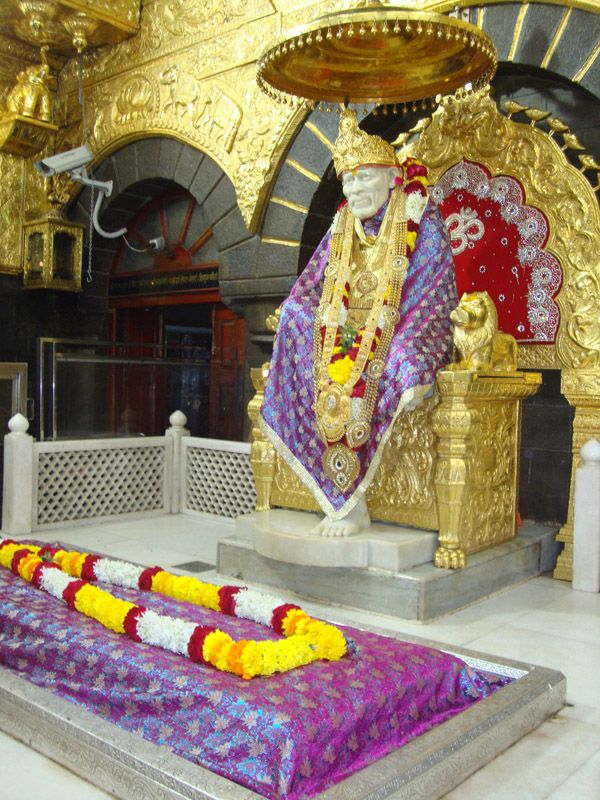
The temple has an assembly hall for about 600 devotees. The first floor of the temple has the pictures depicting the life of the saint. The temple opens on 5 AM with morning prayers and close down at 10 PM with night prayers. The daily routine of the temple starts at 5 o’clock in the morning with Bhupali, a morning song, and closes at 10 o’clock in the night after the Shejarati is sung. Only on three occasions the temple is kept open overnight i.e. on Guru Poornima, Desersa, and Ramanavami. Every Thursday and on each festival, a Palakhi with Baba’s photo is taken out from the temple.
Dwarkamai
Shri Sai Baba came to Shridhi with a marriage procession. He stayed at Dwarkamai till the very end of his life. Dwarkamai is situated on the right of the entrance of Samadhi Mandir. Here he solved problems of the people, cured their sickness and worries. Before Baba’s arrival in Shridhi, Dwarkamai was an old mosque in a dilapidated condition. Baba turned it into Dwarkamai and proved that God is one. The first level of Dwarkamai has a portrait of Baba and a big stone on which Baba used to sit. This level has two rooms. One contains the chariot and the second a Palakhi. Just in front of the room where the chariot is kept is a small temple. A saffron flag flies over it. The second level of Dwarkamai has a square stool made of stone, which Baba used for taking a bath. The main attraction of this place is the oil painting of Shri Sai Baba sitting in a carved wooden shrine. This level also has the grinding stone and the wooden vessel called Kolamba in which Baba used to keep the Bhiksha brought from the village. Chawdi Mandir: On every alternate day Baba used to proceed in procession from Dwarkamai to this place at night & halt & sleep here.
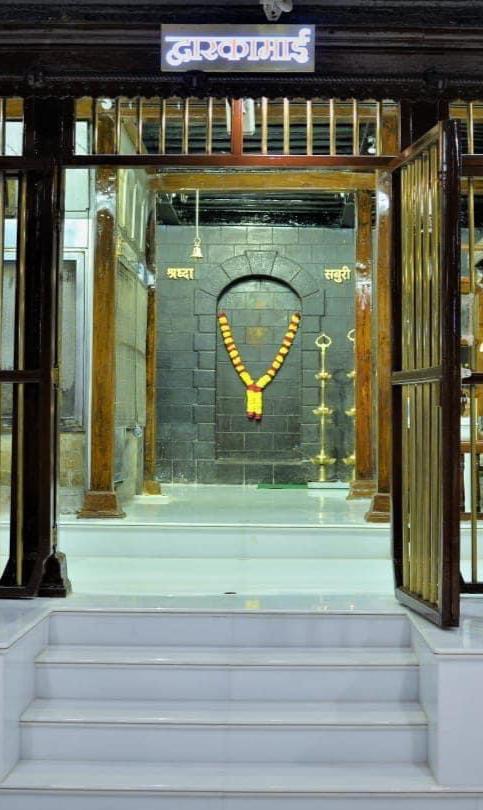
Now also on every Thursday Palanquin procession of Baba’s Photo. Holy Padukas & Satka is taken to this place between 9.15 p.m. & 10.00 p.m. The Chavadi is divided into two parts. One part of the Chavadi has a large portrait of Baba along with a wooden bed and a white chair belonging to him.
Gurusthan
Sai Baba first came to Shirdi in the form of Bal Yogi – a child ascetic. He was first spotted seated under a Neem tree. This place came to be known as Gurusthan. The Gurusthan was renovated on 30th September, 1941. After this the present temple was built. There is a small shrine in Gurusthan. On a elevated platform of this shrine a big portrait of Baba is placed. On the side is a marble statue of Baba. In front of the portrait is a Shivling and the Nandi. Photos of twelve Jyotirlingas are also kept in the temple. The branches of the Neem tree have come out through the roof of the temple. At a short distance lies Baba’s CHAVADI. Baba used to sleep here every alternate day. The Chavadi is divided into two parts.
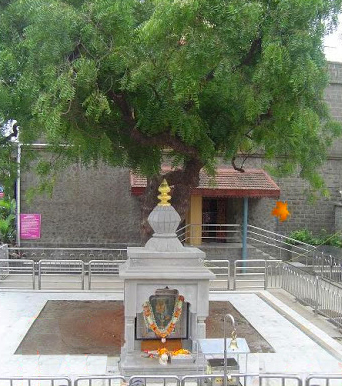
One part of the Chavadi has a large portrait of Baba along with a wooden bed and a white chair belonging to him. There is a cottage of Abdul Baba, an ardent devotee of Shri Sai Baba, in front of the Chavadi. The Lendi Baug was looked after by Abdul Baba. There are photos and various things which were handled by Sai Baba and Abdul Baba in the cottage. There is a Maruti Mandir located at some distance from the cottage of Abdul Baba. This mandir was visited by Baba for the sat-sang with Devidas, a Balyogi, who lived at the Mandir ten to twelve years before Baba arrived. There are also temples of village deities like Shani, Ganpati, and Shankar to be visited.
Lendi Baug
At some distance from Gurusthan there is the Lendi Baug. This Baug was made and watered daily by Baba himself. It got its name from a Nalla (a drain) which used to previously flow there. Baba used to come here every morning and afternoon and rest under a Neem tree. Baba dug a pit, 2 feet deep, under the Neem tree and kept a Deep(earthen lamp) lit in that pit. One octangular Deepgriha called Nanda Deep has been built in marble stone in memory of this place. It constantly burns in a glass box.
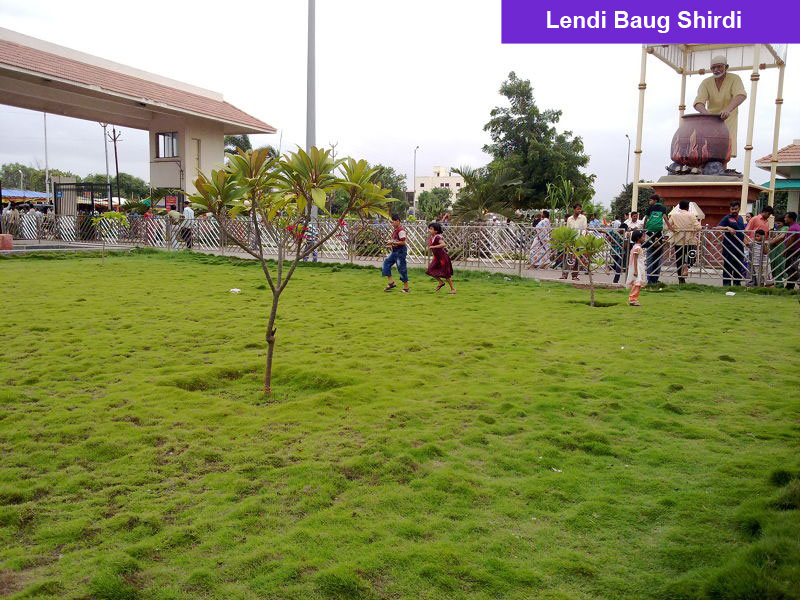
On one side of the Deepgriha is a Peepal tree and on the other side is a Neem tree. Some distance away is a Datta Mandir below an Audumbar tree. In the Mandir there is a statue of Datta built in marble stone. The statue of Datta was installed on 6th December, 1976. Just behind the Datta Mandir is a Samadhi of the horse, Shyamsundar which belonged to Baba and which used to bow to him. Lendi Baug also has a well which was dug by Baba and his devotees.
At the entrance of the Baugh are the Samadhi’s of ardent Sai devotees Tatya Kote Patil, Bhau Maharaj Kumbhar, Nanavalli and Abdul Baba.
Khandoba Mandir
This temple is situated on the main road. In front of this temple Baba was welcomed by Poojari Mhalsapati, of this temple, who said “Aao Sai”, when Baba stepped in Shridi. In this temple there are icons of Khandoba, Banai and Mhalsai.
The three temples in Shirdi temple complex (Lord Ganesh Temple Shirdi, Shani Temple Shirdi and Shiva Temple Shirdi) very near to Samadhi Temple. Sai Baba often gave money for repairs of these temples.
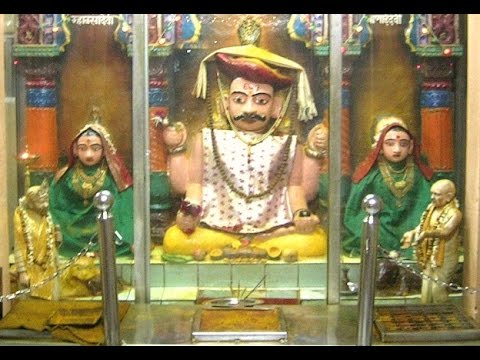
Khandoba Temple Shirdi
Mahalaxmi Temple Shirdi
Hanuman Temple Shirdi (on the way left from Dwarkamai to Chavdi)
Narshima Temple Shirdi
Jain Temple Shirdi
The five Samadhis in Shirdi (Abdul Baba, Tatya Kote Patil, Nanavali, Bhau Maharaj Kumbhar, V. P. Iyer).
Shirdi temple complex which is the main attraction of Shirdi covers an area of about 200 sq. m. The temple complex includes Khandoba, Gurusthan, Samadhi Mandir, Dwarkamai, Chavadi and Lendi Baug. Maruti Temple and Shani Temple, constructed under the supervision of Shirdi Sai Baba, are the other places of attraction in Shirdi.
Lighting lamps with water
Long before Sai Baba’s fame spread, he was fond of burning lights in his Masjid and other Temples. But for the oil needed in those little earthenware lights that he lit, he depended on the generosity of the grocers of Shirdi. He had made it a rule to light earthenware lamps in the masjid every evening and he would call on the grocers for small donations. But there came a time when the grocers got tired of giving oil free to Sai Baba and one day they bluntly refused to oblige him, saying they had no fresh stocks. Without a word of protest Sai Baba returned to the masjid. Into those earthenware lamps he poured water and lighted the wicks. The lamps continued to burn deep into the midnight. The matter came to the notice of the grocers who now came to Sai Baba with profuse apologies. Wouldn’t Sai Baba kindly pardon them? Sai Baba pardoned them, but he warned them never to lie again. “You could have refused to give me the oil, but did you have to say that you didn’t have fresh stocks?” he admonished them. But he had made his point.
Premonition of burning fields
Once, harvesting in Shirdi had been completed and the foodgrains of the entire village had been stored in a yard. The summer was on. The heat was intense as only those who have lived in Shirdi know. One afternoon Sai Baba summoned Kondaji Sutar and said to him: “Go, your field is on flrel” Frightened, Kondaji ran to his field and. frantically looked around for any sign of fire. There wasn’t any. He returned to the masjid and informed Sai Baba that he had looked everywhere but had found no trace of fire and why did Baba have to frighten him? Unfazed, Baba said : “You better turn back and look again.” Baba was right after all. Kondaji noticed that a sheaf of corn was indeed on fire and smoke was billowing from it. A strong wind was fanning the fire and word had gone round to the villagers who now came running to the scene. “Sai Baba,” the people shouted “help us, help us put the fire out!” Thereupon, Sai Baba walked casually towards the yard, sprinkled some water on a stack of sheaves and said: ” There now! The fire will die down!” And so it happened
Stopping the rain
There is the story of one Rao Bahadur Moreshwar Fradhan who had come to Shirdi to take Sai Baba’s darshan along with his wife. As the couple were about to leave, it began to rain heavily. Thunder and lightning rent the air. As the Pradhan couple looked round in dismay, Sai Baba prayed. “Oh Allah!” he intoned, “let the rains cease. My children are going home. Let them go peacefully!” The storm thereupon ceased, the downpour reduced to slight drizzle and the Pradhans were able to reach their destination safely.
Flow of Godavari (river) from Baba's feet
These were instances of things they had seen with their own eyes. It was not secondhand information they had gathered. Sai Baba was to them as real as their homes and their fields and their cattle and the distant hills.Das Ganu once had an unforgettable experience. On a festive occasion, he sought Baba’s permission to go to a place called Singba on the banks of the Godavari to have a bath in the holy waters. “No,” Baba replied resolutely, “where is the need to go all the way when the Godavari is here right at my feet?” Das Ganu was vexed. He was willing to concede that Ganga the holy river (Baba frequently referred to Godavari as Ganga) rose from the feet of Sri Narayana (one among the Hindu trinity of Gods) himself, but his faith was not deep enough to believe that the waters of the Godavari could spring form the feet of his master, Sri Sai. Baba who was reading Das Ganu’s mind decided that this was the time to strengthen Das Ganu’s faith. He told his devotee: “come closer to me and hold the hollow of your palms at my feet!”. As soon as he did so water flowed freely out of the toes of the master’s feet and filled the hollow of Das Ganu’s palms in no time. His joy knew no limits. He sprinkled the water on his head and his body and distributed some more among the assembled devotees as tirtha (holy water).
ELEVEN ASSURANCES OF SAI BABA
Whoever puts his feet on Shirdi soil, his sufferings would come to an end.
The wretched and miserable would rise into plenty of joy and happiness, as soon as they climb the steps of my Mosque.
I shall be ever active and vigorous even after leaving this earthly body.
My tomb shall bless and speak the needs of my devotees.
I shall be active and vigorous even from my tomb.
My mortal remains would speak from my tomb.
I am Ever living to help and guide all, who come to me, who surrender to me and who seek refuge in me.
If you look at me I look at you.
If you cast your burden on me, I shall surely bear it.
If you seek my advice and help, it shall be given to you at once.
There shall be no want in the house of my devotees.



